Game Ready 430.86 Driver Performance Analysis featuring the RTX 2070 and the GTX 1060 using 42 Games
As a regular BabelTechReviews’ feature, this driver performance analysis will showcase the performance of the RTX 2070 Founders Edition (FE) and the GTX 1060-6GB SC with 42 PC games using the latest GeForce Game Ready 430.86 Driver which released earlier this week. We will compare these drivers versus 430.64. 
Earlier this week, we documented the performance changes of the latest Windows version 1903 from 1809 with the same GeForce cards and found almost no performance changes in gaming. We benchmark at 1920×1080 and at 2560×1440 resolutions using the latest games and we also added ARMA III, Conan Exiles, and ARK: Survival Evolved.
We recently upgraded our testing platform using a Core i7-8700K which turbos all 6 cores to 4.8GHz (from 4.7GHZ), an EVGA Z370 FTW motherboard, and 16GB of T-FORCE XTREEM DDR4 at 3866MHz (from 3333MHz) The games tested, settings, and hardware are identical except for the driver versions being compared.
Test Configuration – Hardware
- Intel Core i7-8700K (HyperThreading and Turbo boost are on to 4.8GHz for all cores; Coffee Lake DX11 CPU graphics).
- EVGA Z370 FTW motherboard (Intel Z370 chipset, latest BIOS, PCIe 3.0/3.1 specification, CrossFire/SLI 8x+8x), supplied by EVGA
- T-FORCE XTREEM (2×8 GB, dual channel at 3866 MHz), supplied by Team Group
- RTX 2070 Founders Edition 8GB, at Founders Edition clocks, on loan from NVIDIA
- EVGA GTX 1060 SC 6GB, at SC clocks, on loan from EVGA
- 480 GB Team Group SSD
- 1.92 TB San Disk enterprise class SSD
- 2 TB Micron 1100 SSD
- Seasonic 850W Gold Focus power supply unit
- EVGA CLC 280mm CPU water cooler, supplied by EVGA
- EVGA Nu Audio stereo PCIe sound card, on loan from EVGA
- Edifier R1280T active desktop speakers
- Grado SR60e headphones
- EVGA DG-77, mid-tower case supplied by EVGA
- Monoprice Crystal Pro 4K
Test Configuration – Software
- Nvidia GeForce 430.64 and 430.86 WHQL drivers.
- VSync is forced off.
- AA enabled as noted in games; all in-game settings are specified
- Gaming results show average frame rates in bold including minimum frame rates shown on the chart next to the averages in a smaller italics font.
- Highest quality sound (stereo) used in all games.
- Windows 10 64-bit Home edition. All DX11 titles were run under DX11 render paths. DX12 titles are generally run under the DX12 render path unless performance is lower than with DX11. Three games use the Vulkan API.
- Latest DirectX
- All 42 games are patched to their latest versions at time of publication.
- MSI Afterburner, latest beta.
- OCAT, latest version
- Fraps, latest version
- Yet Another ARMA Benchmark
42 PC Game benchmark suite & 3 synthetic tests
Synthetic
- Firestrike – Basic & Extreme
- Time Spy DX12
- Superposition
DX11 Games
- ARMA III
- Grand Theft Auto V
- The Witcher 3
- Fallout 4
- Rainbow Six Siege
- Overwatch
- For Honor
- Ghost Recon Wildlands
- Mass Effect: Andromeda
- Prey
- ARK: Survival Evolved
- Project CARS 2
- Middle Earth: Shadow of War
- Total War: Warhammer II
- Destiny 2
- Star Wars: Battlefront II
- Monster Hunter: World
- Kingdom Come: Deliverance
- Final Fantasy XV
- Far Cry 5
- Conan: Exiles
- F1 2018
- Assassin’s Creed: Odyssey
- Call of Duty: Black Ops 4
- Hitman 2
- Just Cause 4
- Resident Evil 2
- Anthem
- Devil May Cry 5
DX12 Games
- Ashes of the Singularity: Escalation
- Deus Ex Mankind Divided
- Gears of War 4
- Civilization VI
- Sniper Elite 4
- Forza 7
- Shadow of the Tomb Raider
- Battlefield V
- Metro Exodus
- Tom Clancy’s The Division 2
Vulkan Games
- DOOM
- Wolfenstein: The New Colossus
- Strange Brigade
NVIDIA Control Panel settings
Here are the NVIDIA Control Panel settings.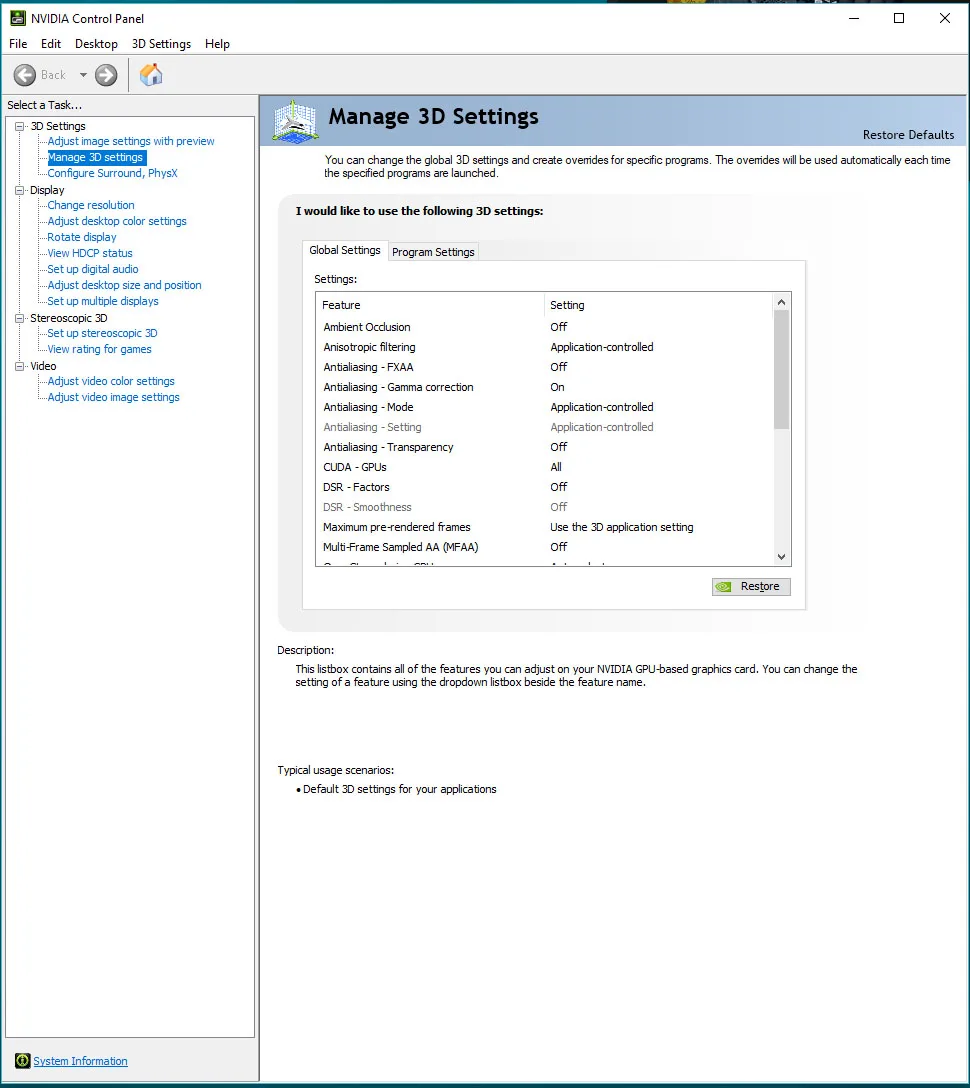
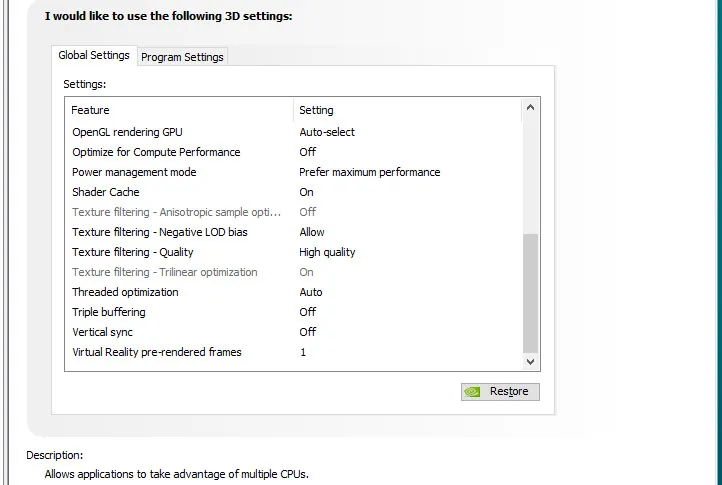 We used MSI’s Afterburner to set our two GeForce cards’ highest Power and Temperature targets. By setting the Power Limits and Temperature limits to maximum, they can maintain their maximum clocks without throttling.
We used MSI’s Afterburner to set our two GeForce cards’ highest Power and Temperature targets. By setting the Power Limits and Temperature limits to maximum, they can maintain their maximum clocks without throttling.
Game Ready GeForce 430.86 WHQL Drivers
This latest GeForce Game Ready 430.86 driver was released on Monday (5/27/19) primarily for the upcoming June 6 release of RTX Quake II. It is also from a new branch of GeForce drivers which adds support for Windows 10’s May update including variable rate shading. This new driver is also supposed to provide the best experience for GeForce gamers who play Assetto Corsa Competizione.
The download links for the latest GeForce 430.86 drivers can be found starting here. The release notes can be found here as a downloadable pdf file. The included highlights below are quoted from NVIDIA’s website:
Game Ready Drivers provide the best possible gaming experience for all major new releases, including Virtual Reality games. Prior to a new title launching, our driver team is working up until the last minute to ensure every performance tweak and bug fix is included for the best gameplay on day-1.
Game Ready
Provides the optimal gaming experience for Quake II RTX and Assetto Corsa Competizione
Gaming Technology
Adds support for three new G-SYNC compatible monitors
Adds support for Oculus Rift S and HTC VIVE Pro Eye HMDs
###
Let’s head to the charts to compare the driver performance changes from the GeForce 430.64 drivers to the latest 430.86 Game Ready Drivers.
The Summary Chart
Below are the summary charts of 42 games and 3 synthetic tests used to compare the performance changes for the RTX 2070 and the GTX 1060 from the 430.64 GeForce drivers to the most recent 430.86 drivers. The highest settings are always chosen and the settings are listed on the charts. Open each chart in a separate window or tab for best viewing.
Most results show average framerates and higher is better. Minimum framerates are next to the averages in italics and in a slightly smaller font. A few games benched with OCAT show average framerates but the minimums are expressed by the 99th percentile frametime in ms where lower numbers are better.
The first column shows the GTX 1060’s performance with the latest 430.86 driver and columns two represents the 430.64 driver’s performance. The third column shows the RTX 2070’s performance with the latest 430.86 driver and column four represents the 430.64 driver’s performance. Wins between the two sets of drivers are shown by colored text. If both sets of results are equal, they are both shown in colored text.
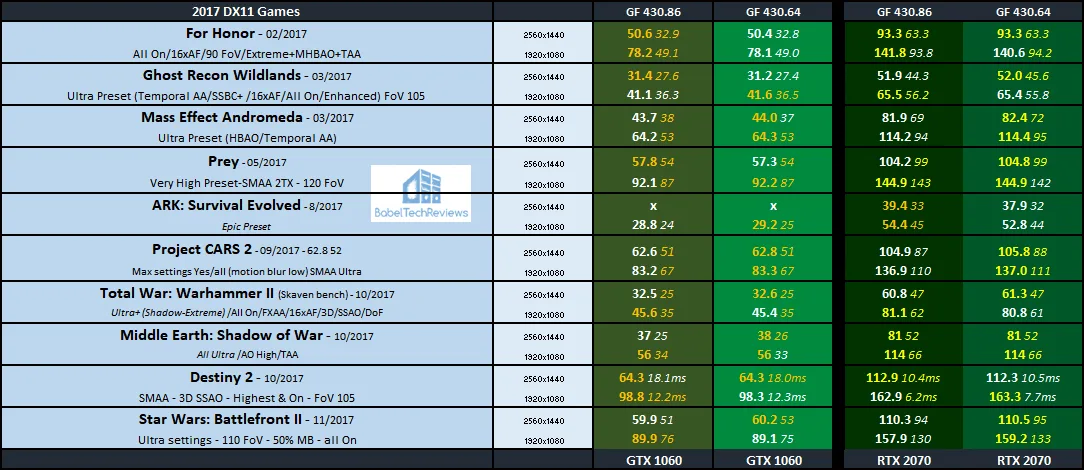
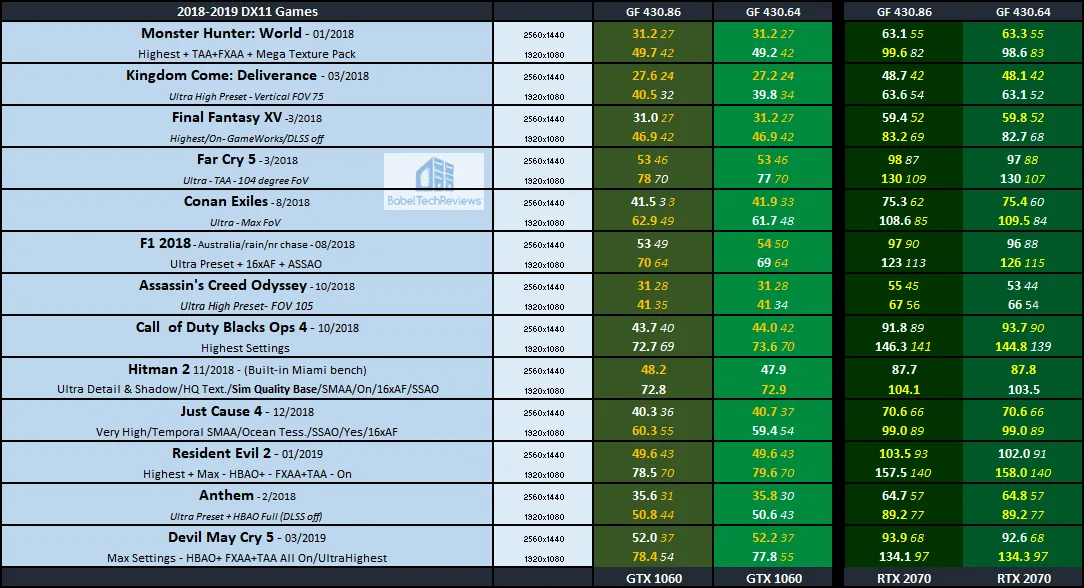
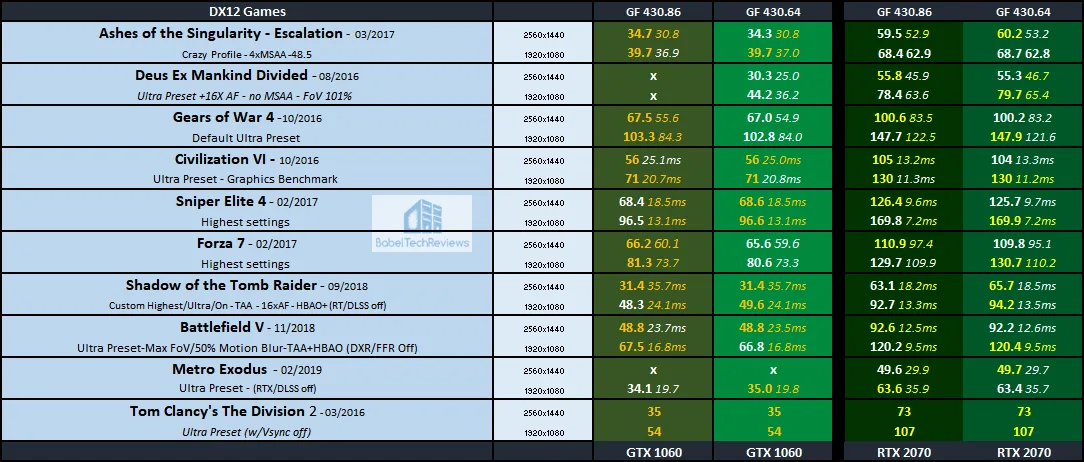
 We encountered a single bug with the GTX 1060 that has occurred in the past where Deus Ex: Mankind Divided refuses to launch in DX12 with the latest driver. There aren’t any real performance increases nor decreases from 430.64 to 430.86 that cannot be explained by “benchmarking noise”; the results are mostly all within the benchmarking margin of error.
We encountered a single bug with the GTX 1060 that has occurred in the past where Deus Ex: Mankind Divided refuses to launch in DX12 with the latest driver. There aren’t any real performance increases nor decreases from 430.64 to 430.86 that cannot be explained by “benchmarking noise”; the results are mostly all within the benchmarking margin of error.
Let’s head to our conclusion.
Conclusion
Generally we mostly see incremental changes from one driver set to the other but nothing substantial and they generally lie within the benchmarking margin of error. Some of these performance changes may be influenced more by game patches than by drivers.
We would recommend upgrading to the latest Game Ready 430.86 driver from older driver sets because there are generally stability, security, or performance advantages. We found the latest drivers to be stable and relatively bug-free overall except as noted above.
Next up, we are returning to VR. We promise.
Happy gaming!
